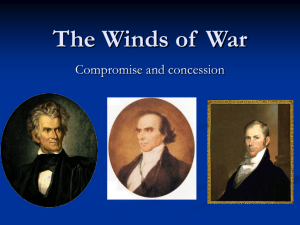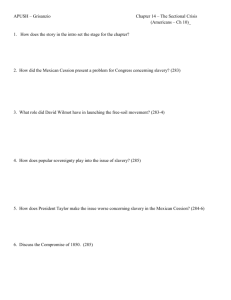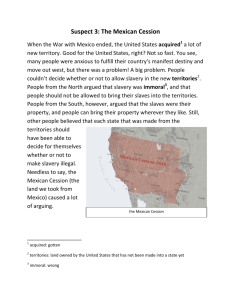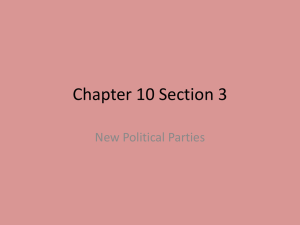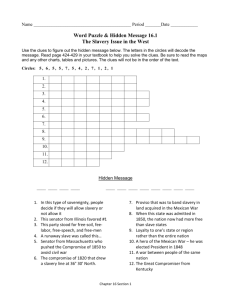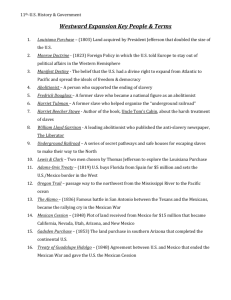The Mexican Cession
advertisement
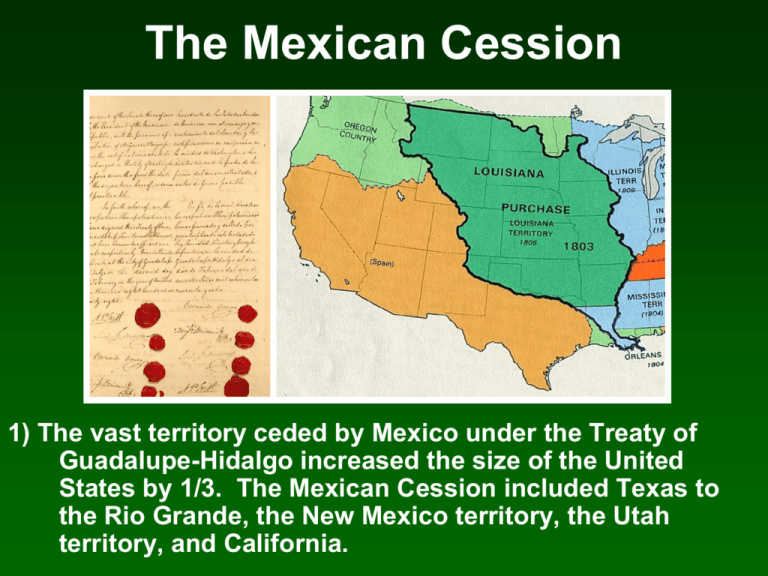
The Mexican Cession 1) The vast territory ceded by Mexico under the Treaty of Guadalupe-Hidalgo increased the size of the United States by 1/3. The Mexican Cession included Texas to the Rio Grande, the New Mexico territory, the Utah territory, and California. The Mexican Cession 2) Despite the fulfillment of Manifest Destiny, the Mexican Cession revived the intense debate over the extension of slavery in the territories. Southerners felt that their military service in the Mexican-American War ensured that any ceded territory would be open to slavery. Anti-slavery northerners opposed the Mexican War because they considered it a southern scheme to expand the “slaveocracy.” The Mexican Cession 3) Many Northerners believed that the Missouri Compromise had settled the boundaries of slavery in 1820. However, after eleven years as an independent republic, slaveholding Texas was annexed by the United States in 1845. Southerners argued that the acquisition of new territory renewed the prospect for the extension of slavery in the West. The Mexican Cession 4) At the outbreak of war in 1846, Congressman David Wilmot of Pennsylvania added an amendment to a war appropriations bill that prohibited slavery in any territory gained from Mexico. The “Wilmot Proviso” passed the House of Representatives twice, but the bill was defeated in the Senate. The Mexican Cession 5) Transcendentalist Ralph Waldo Emerson commented that, “Mexico will poison us.” Even Senator John C. Calhoun of South Carolina prophetically warned that, “Mexico is to us the forbidden fruit…the penalty of eating it would be to subject our institutions to political death.” The Election of 1848 3) Poor health led President James K. Polk not to seek reelection and the Democrats nominated War of 1812 veteran, General Lewis Cass. The Democratic platform remained silent concerning the issue of slavery, but Cass was known to support the extension of slavery through a policy known as “popular sovereignty.” This process gave the people of a given territory the power to vote on the issue of slavery within their own borders. The Election of 1848 4) The Whigs nominated General Zachary Taylor and campaigned on his reputation as the “Hero of Buena Vista.” The Whig platform was also silent concerning slavery, but the fact that Taylor was the owner of a large sugar plantation in Louisiana left little doubt concerning his stance on the issue. The Election of 1848 5) Anti-slavery voters in the North distrusted both candidates and formed the Free-Soil Party in protest. The new third party strongly opposed the extension of slavery in the western territories. The Election of 1848 - = 8) Zachary Taylor’s status as a recent war-hero naturally made him the most popular candidate. The Free Soil Party also increased Taylor’s margin of victory by taking northern Democratic votes away from Lewis Cass. The Gold Rush 1) Regardless of the raging free-soil debate, the Mexican Cession proved to be immensely profitable when a California pioneer discovered shiny specks of gold in the American River in early 1848. The Gold Rush 5) In an effort to erect an effective government, the citizens of California drafted a Constitution and applied to Congress in 1849 as a free state. The California Gold Rush renewed the free-soil debate and resulted in a fierce sectional battle over the question slavery in the west. The Gold Rush 6) The question of California statehood produced a severe sectional crisis in 1850. A) Southerners argued that the defeat of the Wilmot Proviso ensured that the territories of the Mexican Cession would be open to slavery. The Gold Rush B) Southerners also felt that their military service in the Mexican-American War ensured that any territory gained from Mexico would be open to slavery. The Gold Rush ? C) The Missouri Compromise of 1820 was in question because the extension of the 36*30’ line would divide California. Southerners feared that a “free soil” California would inevitably lead to the prohibition of slavery in the rest of the Mexican Cession. (The New Mexico and Utah territories) The Gold Rush D) The addition of free California was also opposed by Southerners because it would upset the delicate balance of power in the U.S. Senate of 15 slave states and 15 free states. The Immortal Trio 1) The eruption of so many sectional issues related to slavery seemed to increase the possibilities of secession, disunion, and even Civil War. The growing divide between North and South made the prospect of political compromise much less likely. The Immortal Trio 2) The sectional crisis of 1850 brought together the greatest assemblage of distinguished statesmen since the Constitutional Convention of 1787. The “Old Guard” of this dying generation brought the “Immortal Trio” of Henry Clay (Kentucky), Daniel Webster (Massachusetts), and John C. Calhoun (South Carolina) together on the public stage for the last time. The Immortal Trio 3) The Immortal Trio would be joined and assisted by the new generation of leadership known as “Young Gladiators.” This group included Senators, Stephen A. Douglas (Illinois), Charles Sumner (Massachusetts), and William H. Seward (New York). Henry Clay’s Role (Kentucky) 1) “Great Compromiser” Henry Clay of Kentucky played a pivotal role in the increasingly sectional debate raging in Congress. The aging Whig leader came out of retirement in order to construct a complex series of compromises that would appease both northern and southern grievances. The Compromise of 1850 1) The Compromise of 1850 was a series of five different compromises on a variety of sectional issues: A) California was accepted into the Union as a free state. The Compromise of 1850 B) The territories of Utah and New Mexico would determine slavery though the process of “Popular Sovereignty” (where the residents of a territory vote to determine their state’s policy on slavery). The Compromise of 1850 Plus $10 Million C) The Texas border dispute was settled in favor of New Mexico, but the federal government paid Texas $10 million dollars in order to eliminate its foreign debts. The Compromise of 1850 D) Slavery was allowed to continue in Washington D.C., but the slave trade was abolished within the nation’s capital. The Compromise of 1850 E) The major concession to the South was the passage of a much more stringent fugitive slave law. This gave Southerners considerable power to enter northern free-states in order to recapture their fugitive property. The Fugitive Slave Law 1) Under the Fugitive Slave Law, accused blacks were not given the right to testify in their own behalf and were denied a jury trial. Federal commissioners who handled a fugitive slave case were awarded five dollars if the runaway was freed and ten dollars if they were found guilty. The Fugitive Slave Law Harriet Beecher Stowe Gerrit Smith 2) Northerners that violated the law by assisting runaways now faced federal prosecution, strict fines, and even jail sentences. Northern resentment of the law helped transform many former moderates into vocal opponents of slavery. The Fugitive Slave Law 6) William Lloyd Garrison denounced the new law declaring, “We execrate it, we spit upon it, we trample it under our feet.” The Fugitive Slave Law 7) Southerners felt betrayed by the northern defiance of the Fugitive Slave Law. The sectional divide proved too great for Clay’s delicate compromise of 1850. Both political parties would be hopelessly divided in the election of 1852, but the ruling Whig Party imploded as a result of the so-called compromise.
